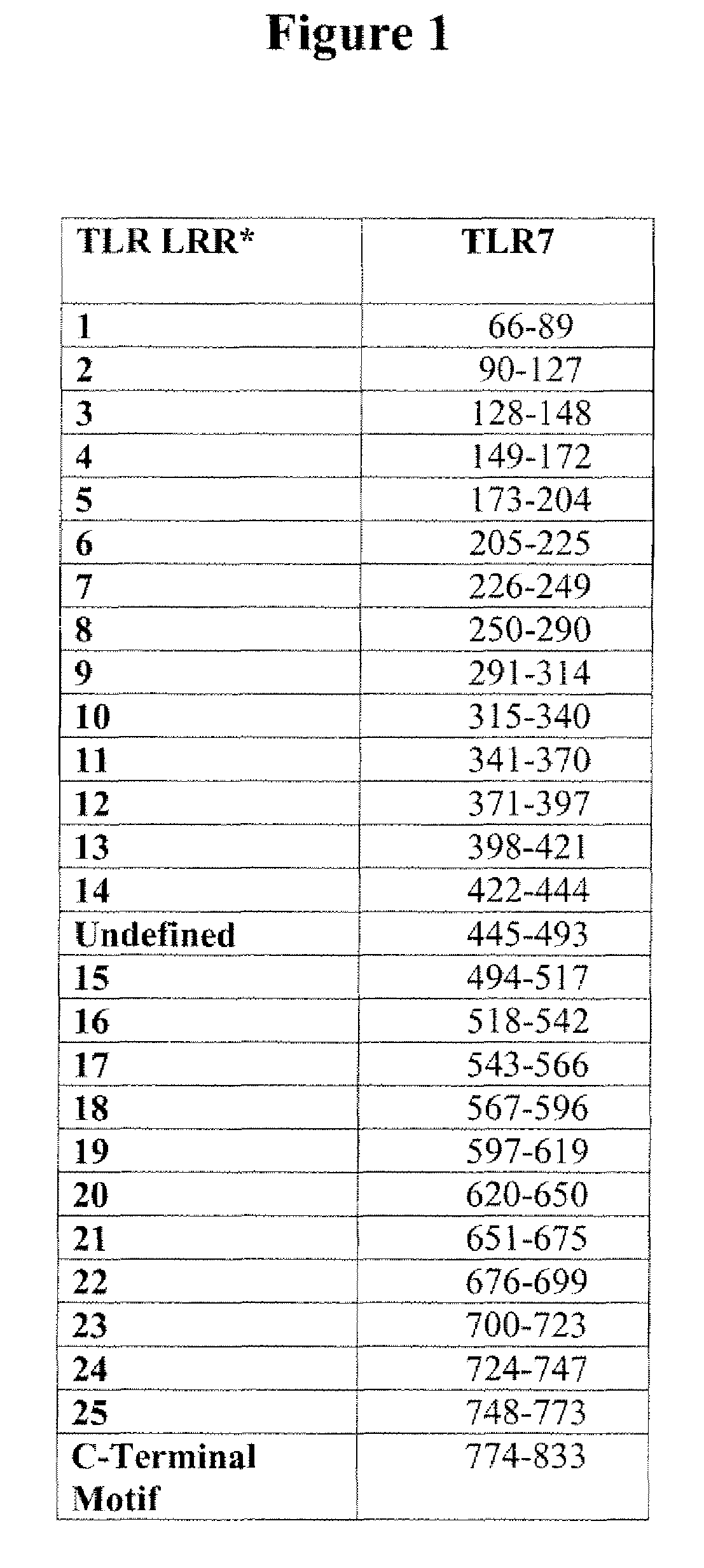Screening assay for TLR7, TLR8 and TLR9 agonists and antagonists
a technology of agonists and antagonists, applied in the field of compound identification, can solve problems such as difficult to achieve concentrations, and achieve the effect of efficient screening methods
- Summary
- Abstract
- Description
- Claims
- Application Information
AI Technical Summary
Benefits of technology
Problems solved by technology
Method used
Image
Examples
example 1
Construction of Human TLR7 and TLR8 Deletion Mutants
[0068]A nucleic acid sequence (comprising the nucleotide sequence set forth in SEQ ID NO: 1) encoding a mutant human TLR7 protein having a deletion of the amino acid sequence PIPLG (amino acids 102-106 of the wild-type human TLR7 amino acid sequence set forth in SEQ ID NO: 4) in the second LRR was prepared by PCR. Briefly, a first PCR was performed on the human wild-type TLR7 cDNA (SEQ ID NO: 3 cloned into the expression vector pCMVFlag (a derivative of pCR3.1 (Invitrogen, Carlsbad, Calif.)) (pCMVhuTLR7) using the sense primer 5′-CTA ACT AGA GAA CCC ACT GC-3′ (SEQ ID NO: 9) and the antisense primer 5′-GAT GCA CAT GTT GTT TTT TGA TAC ACA GTT GCA TCT GAA ATC-3′ (SEQ ID NO: 10). A second PCR was performed on the TLR7 cDNA using the sense primer 5′-GAT TTC AGA TGC AAC TGT GTA TCA AAA AAC AAC ATG TGC ATC-3′ (SEQ ID NO: 11) and the antisense primer 5′-CTT CAC TTG AAT CTC CTG AAG-3′ (SEQ ID NO: 12). The bands were gel purified and combine...
example 2
Expression and Activation of Human TLR7 and TLR8 Deletion Mutants
[0071]A comparison of the response of wild-type and mutant TLR7 and TLR8 proteins to agonist activation was performed. HEK 293 cells were transfected in bulk in 15 cm dishes with a mixture of NFκB-luciferase reporter plasmid (Clontech) and pCMVhuTLR7Δ2 or pCMVhuTLR8Δ2. Six hours after transfection, cells were divided into 96- or 384-well plates at different cell densities to achieve a degree of confluency between 25-100%. The next day, increasing concentrations of the TLR7 agonists R848, loxoribine, and uridine were added to the wells. Wells without agonist served as negative controls. After five hours, the cells were lysed with SteadyGlo™ luciferase reagent (Promega) according to the manufacturer's recommendations. After a 10-minute incubation period, luciferase activity was measured using a luminometer. The data were plotted as a fold-induction compared to luciferase activity of cells which received medium alone.
[007...
PUM
| Property | Measurement | Unit |
|---|---|---|
| concentrations | aaaaa | aaaaa |
| solubility | aaaaa | aaaaa |
| resistance | aaaaa | aaaaa |
Abstract
Description
Claims
Application Information
 Login to View More
Login to View More - R&D
- Intellectual Property
- Life Sciences
- Materials
- Tech Scout
- Unparalleled Data Quality
- Higher Quality Content
- 60% Fewer Hallucinations
Browse by: Latest US Patents, China's latest patents, Technical Efficacy Thesaurus, Application Domain, Technology Topic, Popular Technical Reports.
© 2025 PatSnap. All rights reserved.Legal|Privacy policy|Modern Slavery Act Transparency Statement|Sitemap|About US| Contact US: help@patsnap.com

